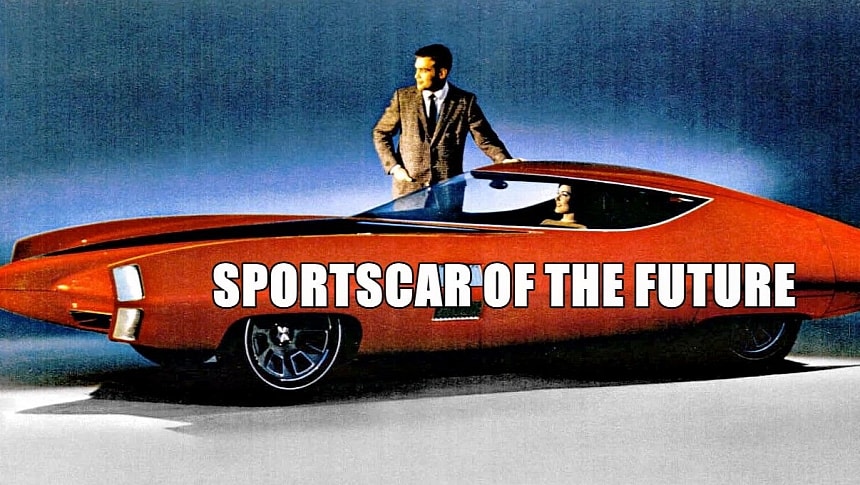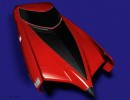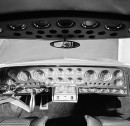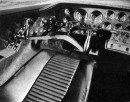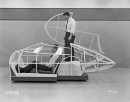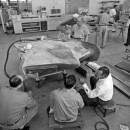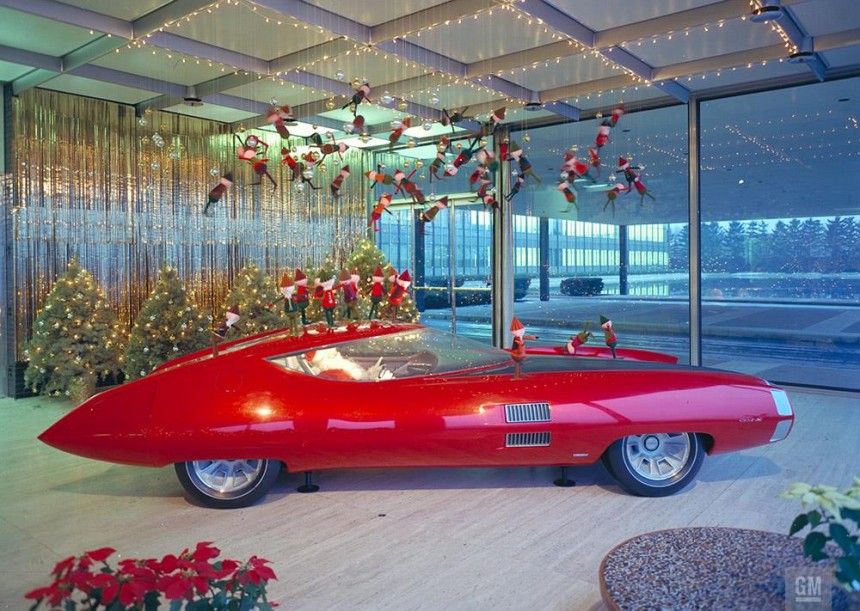If the current state of automotive design has you feeling underwhelmed or positively disappointed in the apparent lack of creativity, the GM-X Stiletto concept will be like balm for your eyes. Hailing back to the era of space infatuation, this 1964 piece of rolling art was introduced as the sportscar "of the next decade."
The phrase "car of the future" is overused these days, but it feels natural to the 1964 GM-X Stiletto, General Motors' outstanding, though rather-late contribution to space age automotive design. It never made it beyond concept stage but, for that matter, it was never intended for mass production, which explains the insane amount of state-of-the-art tech packed inside and the outlandish design.
Put in much simpler words, the GM-X Stiletto was the car of the future as imagined by a handful of young designers from the Advanced Development Department, no longer constrained by considerations of safety, practicality, fuel economy, or feasibility. In short, it was the absolute dream car: a two-person daily driver designed as a most poignant love letter to aerospace design.
Because it was never intended as more than a concept and showcase model, the GM-X Stiletto never moved a single foot under its own power. Indeed, a powertrain was never even put in, because the purpose was to showcase design. As such, a rolling chassis would do, and that's precisely what the Stiletto got.
GM first introduced a scale model of the concept in metal and acrylic, painted red, black, and silver. Then, at the 1964-1965 New York World's Fair in the GM Futurama Pavilion's Avenue of Progress mall, the full-size concept was unveiled to the world. Described as "the sportscar of the next decade," the GM-X Stiletto took aerospace design cues to the next level, coming across as the closest thing to a flying car.
The sharp, elongated silhouette, with the wheels pushed under the body and almost entirely hidden from view, appeared to be hovering in place. Large fins at the rear and a pointed nose that would have probably caused panic among pedestrians at any crossing, completed the rocket vibe that the Stiletto was going for.
There was no subtlety in the way designers chose to integrate aerospace elements into the concept car, but that was on purpose. Remember, this was a time when everything was on the nose in marketing, and subtlety was an underappreciated and undervalued art. The Stiletto was meant to look fast and futuristic, and that's exactly what designers were able to achieve.
But the merits of this probably-lost iconic concept car (the GM-X Stiletto is ranked among the world's greatest concept cars of all times, by the way) go beyond its aesthetic appeal. Because they no longer had to pay any mind to feasibility or safety, designers were able to spec the vehicle as the ultimate dream car. This meant unprecedented features and a lot of tech – the best they had at the time.
For instance, the GM-X Stiletto had no doors and, because of it, no opening windows. Access was done by means of a lateral opening hatch that integrated the entire roof, so the car opened up much like a clamshell. Any auto enthusiast today could rant for days on the many downsides of such an opening mechanism or the many ways in which it could end in disaster for the user, but attendees at the Fair loved the proposal. Nothing says "futuristic" like a car that opens up like they imagined a UFO would, right?
The GM-X Stiletto didn't just lack doors; it also lacked front pillars, which, in turn, allowed for a wraparound windshield that offered excellent visibility. Again, safety and practicality in everyday scenarios, especially with long-term use, were no concern in the design, so don't even bother pointing out how that would have been a total nuisance in a production model. The glass was covered in a water-repellent compound, so there was no need for a wiper.
Because the windows didn't open, communication with the outside world was possible through a three-way comms system. You could theoretically rage at another driver through the integrated speakers, assuming you'd scoop to this while driving such a fancy-looking rocket car.
The aerospace inspiration remained very obvious inside, as well. The interior was all-silver, making a contrasting note with the custom red exterior, and featured an incredible number of displays, buttons, and gauges, much like you'd find in the cockpit of a fighter jet. According to GM, the GM-X Stiletto had 30 flashing lights, 29 controls, and 16 gauges, which took up the entirety of the dashboard and a big chunk of the space above.
Steering was done by means of an aircraft-style yoke, with designers imagining it doing half a turn from lock to lock. To allow that, they also imagined the wheels being turned by electric motors that enabled different gear ratios according to each occasion: a larger angle for tight spots like parking lots and a smaller one at highway speeds.
Features included automatic climate control to keep the temperature at a preset value in the cabin at all times, a rearview camera with a live feed on one of the screens in the cockpit, ultrasonic sensors to detect distance to an incoming obstacle, and a proto-version of today's AI "assistant." GM-X Stiletto was capable of warning drivers in a female voice about the imminent need for an oil replacement or a fuel stop.
After a successful run, the GM-X Stiletto was retired and revived with some modifications shortly after, in 1969, as the Pontiac Cirrus concept. Depending on who you believe, the concept is still with General Motors, or it's been crushed unceremoniously after more than a decade in storage. The model that preceded both concepts is with the Henry Ford Museum.
But we'll alwayshave Paris have the incredible photos of this dream "flying" car that never really took off to remember it by. Imagination can do the rest, much like it did in the design of the GM-X Stiletto.
Put in much simpler words, the GM-X Stiletto was the car of the future as imagined by a handful of young designers from the Advanced Development Department, no longer constrained by considerations of safety, practicality, fuel economy, or feasibility. In short, it was the absolute dream car: a two-person daily driver designed as a most poignant love letter to aerospace design.
Because it was never intended as more than a concept and showcase model, the GM-X Stiletto never moved a single foot under its own power. Indeed, a powertrain was never even put in, because the purpose was to showcase design. As such, a rolling chassis would do, and that's precisely what the Stiletto got.
The sharp, elongated silhouette, with the wheels pushed under the body and almost entirely hidden from view, appeared to be hovering in place. Large fins at the rear and a pointed nose that would have probably caused panic among pedestrians at any crossing, completed the rocket vibe that the Stiletto was going for.
There was no subtlety in the way designers chose to integrate aerospace elements into the concept car, but that was on purpose. Remember, this was a time when everything was on the nose in marketing, and subtlety was an underappreciated and undervalued art. The Stiletto was meant to look fast and futuristic, and that's exactly what designers were able to achieve.
For instance, the GM-X Stiletto had no doors and, because of it, no opening windows. Access was done by means of a lateral opening hatch that integrated the entire roof, so the car opened up much like a clamshell. Any auto enthusiast today could rant for days on the many downsides of such an opening mechanism or the many ways in which it could end in disaster for the user, but attendees at the Fair loved the proposal. Nothing says "futuristic" like a car that opens up like they imagined a UFO would, right?
The GM-X Stiletto didn't just lack doors; it also lacked front pillars, which, in turn, allowed for a wraparound windshield that offered excellent visibility. Again, safety and practicality in everyday scenarios, especially with long-term use, were no concern in the design, so don't even bother pointing out how that would have been a total nuisance in a production model. The glass was covered in a water-repellent compound, so there was no need for a wiper.
The aerospace inspiration remained very obvious inside, as well. The interior was all-silver, making a contrasting note with the custom red exterior, and featured an incredible number of displays, buttons, and gauges, much like you'd find in the cockpit of a fighter jet. According to GM, the GM-X Stiletto had 30 flashing lights, 29 controls, and 16 gauges, which took up the entirety of the dashboard and a big chunk of the space above.
Steering was done by means of an aircraft-style yoke, with designers imagining it doing half a turn from lock to lock. To allow that, they also imagined the wheels being turned by electric motors that enabled different gear ratios according to each occasion: a larger angle for tight spots like parking lots and a smaller one at highway speeds.
After a successful run, the GM-X Stiletto was retired and revived with some modifications shortly after, in 1969, as the Pontiac Cirrus concept. Depending on who you believe, the concept is still with General Motors, or it's been crushed unceremoniously after more than a decade in storage. The model that preceded both concepts is with the Henry Ford Museum.
But we'll always
